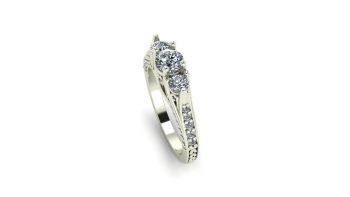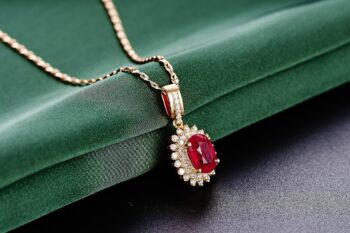Tourmaline is one of the most underused gemstones in jewelry. Which is puzzling because it checks all the boxes you want a stone to check. Tourmaline is durable. It can be relatively inexpensive. And it comes in almost as many colors as sapphire. Which leads us to believe that the issue is marketing! We all know what DeBeers did for diamonds after World War Two. And what better marketing for rubies, sapphires, and emeralds than the fact that they were used on crown jewels for thousands of years. Tourmaline is pretty much unknown, except for those born in October. Go into most jewelry stores, and the won’t have any. IF they do, you will be limited to pink as well.
We think Tourmaline should be used more. So, in this post we will discuss tourmaline and why it makes such a good stone to use in jewelry. We will also discuss its meaning, healing properties and practical uses as it was used for these reasons as much or more than jewelry since it was first found 500 years ago.
What Is Tourmaline?
Tourmaline is a fascinating gemstone known for its wide range of colors, making it a popular choice in jewelry. This gemstone is found in various countries around the world, including Brazil, Afghanistan, and the United States. Tourmaline is prized for its unique ability to display multiple colors in a single stone, a phenomenon known as pleochroism.
In addition to its aesthetic appeal, tourmaline is believed to have metaphysical properties that can promote creativity, balance, and protection. Different colors of tourmaline are thought to have specific meanings and benefits, such as black tourmaline for protection against negative energy and pink tourmaline for emotional healing. Many people choose to wear tourmaline not only for its beauty but also for its perceived metaphysical properties.
Whether you are drawn to tourmaline for its stunning colors or its metaphysical properties, this gemstone is a versatile and captivating choice for jewelry. With its unique color variations and alleged healing properties, tourmaline continues to be a popular gemstone for those seeking beauty and positive energy in their lives.
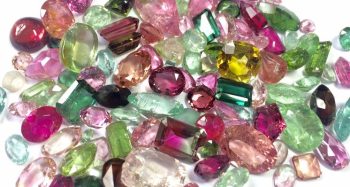
How Is Tourmaline Formed?
Tourmaline forms in a variety of geological settings. It is a complex borosilicate mineral with a unique crystal structure. Tourmaline typically forms in igneous rocks such as granite and pegmatite through a process involving high temperatures and pressures. This gemstone can also be found in metamorphic rocks like schist and marble.
The formation of tourmaline involves the presence of elements like aluminum, iron, and lithium in the host rock. These elements combine with other minerals under specific conditions to create the characteristic crystals of tourmaline. The crystal structure of tourmaline allows it to come in a wide range of colors, from pink and green to blue and black. The presence of different trace elements during its formation contributes to the diverse colors seen in tourmaline gemstones.
Overall, the formation of tourmaline is a complex and intriguing process that results in the creation of one of the most versatile gemstones in the world. Its unique properties and stunning colors make it a popular choice for jewelry and collectors alike. Understanding how tourmaline is formed can deepen appreciation for this beautiful gemstone and the geological processes that shape our world.
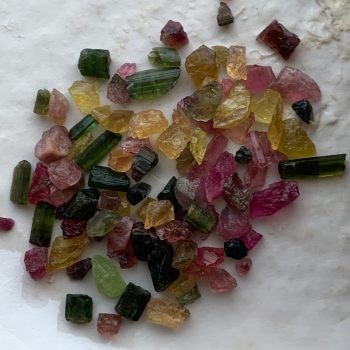
Chemical Makeup & Physical Properties
Tourmaline is a complex borosilicate mineral with a unique chemical composition. It consists of elements such as aluminum, iron, magnesium, sodium, lithium, and potassium. The presence of these elements gives tourmaline its distinctive colors, ranging from black to pink, green, blue, and watermelon. Additionally, tourmaline can contain trace elements like manganese, chromium, and vanadium, further enhancing its color variations.
The chemical formula of tourmaline is quite intricate, typically represented as (Na,Ca)(Li,Al,Fe,Mg)3Al6(BO3)3Si6O18(OH)4. This formula highlights the combination of sodium, calcium, lithium, aluminum, iron, magnesium, boron, silicon, and oxygen in the mineral’s structure. Tourmaline’s complex composition contributes to its unique properties, including its pyroelectric and piezoelectric characteristics, making it valuable in various technological applications.
Tourmaline is a complex borosilicate mineral with a hardness of 7 to 7.5 on the Mohs scale, making it suitable for everyday wear in jewelry. Tourmaline is also pleochroic, meaning it can display different colors when viewed from different angles, adding to its allure and uniqueness.
In addition to its vibrant colors and durability, tourmaline exhibits interesting electrical properties. When heated or subjected to pressure, tourmaline can become electrically charged, attracting lightweight objects like paper or ash. This phenomenon is known as pyroelectricity and piezoelectricity, making tourmaline a gemstone with intriguing physical properties beyond its visual appeal.
Tourmaline Color Range
Tourmaline, a gemstone known for its stunning beauty, comes in a wide range of colors. From vibrant greens to deep blues, rich pinks, and fiery reds, tourmaline offers a spectrum of hues to suit every taste. This gemstone’s color range is truly remarkable, making it a popular choice for jewelry enthusiasts looking for unique and eye-catching pieces.
One of the most sought-after colors of tourmaline is the vivid green variety known as “chrome tourmaline.” This gemstone’s intense green color is often compared to the lush hues of emeralds. This makes it a favorite among those who appreciate rich, vibrant gemstones. On the other end of the spectrum, pink tourmaline, with its delicate and feminine hue, is a popular choice for adding a touch of elegance to any jewelry piece.
Another of Tourmaline’s charms is its bi and tricolor stones. We love the watermelon tourmaline slices! As the name implies, they are red and green. However, tourmaline can come in blue and green, blue and link, as well as blue and grey. Not many gemstone species can say that!

Tourmaline Cost
The cost of tourmaline can vary significantly depending on factors such as color, clarity, size, and origin. Generally, prices can range from $40 to $500 per carat for commercial-grade stones. However, high-quality tourmalines (especially Paraiba) can fetch prices of $1,000 per carat or more. It’s important to purchase tourmaline from reputable dealers to ensure authenticity and quality.
When considering the cost of tourmaline, it’s essential to understand that certain colors command higher prices. For example, the rare Paraiba tourmaline from Brazil can be one of the most expensive varieties due to its vivid blue-green hue. Pink and red tourmalines are also highly sought after and can be priced accordingly. Additionally, larger stones with excellent clarity and color saturation will generally be more valuable than smaller or lower-quality specimens.
To make an informed purchase of tourmaline, it’s advisable to educate yourself on the factors that influence its cost. Consulting with gemstone experts or reputable jewelers can help you navigate the market and find a tourmaline that fits your budget and preferences. Whether you’re drawn to the vibrant hues of Paraiba tourmaline or the classic beauty of pink and red varieties, investing in a quality tourmaline gem can be a rewarding addition to any collection.
History Of Tourmaline
Tourmaline, a gemstone known for its vibrant colors, has a rich history dating back centuries. Believed to have been first discovered in the 1500s in Brazil, it quickly gained popularity for its unique beauty. Over time, tourmaline deposits were found in various parts of the world, including Afghanistan, the United States, and Africa, further increasing its desirability.
Throughout history, tourmaline has been associated with various mystical and healing properties. It is said to promote inspiration, balance emotions, and protect against negative energy. Many cultures have revered tourmaline for its supposed ability to enhance creativity and mental clarity. Today, tourmaline continues to be a popular choice for jewelry due to its wide range of colors, from deep greens to vibrant pinks and blues.
In the world of gemstones, tourmaline stands out for its fascinating history and diverse characteristics. Whether worn for its beauty or believed metaphysical properties, tourmaline remains a gemstone cherished by many for its colorful allure and intriguing past.

Healing Properties
Tourmaline is a gemstone known for its unique healing properties. It is believed to promote a sense of calmness and balance. This makes it a popular choice for those seeking emotional healing. Many people use tourmaline to reduce stress and anxiety, as well as to increase feelings of self-confidence and positivity.
In addition to its emotional benefits, tourmaline is also thought to have physical healing properties. It is said to help purify the body and protect against negative energies. Some people use tourmaline to alleviate chronic pain, boost the immune system, and improve circulation. Whether worn as jewelry or placed in the living space, tourmaline is a versatile gemstone that can support overall well-being.
Overall, tourmaline is a powerful crystal that offers a wide range of healing properties for both the mind and body. Whether you are looking to enhance your emotional well-being, alleviate physical ailments, or simply surround yourself with positive energy, incorporating tourmaline into your life may provide the healing benefits you seek.

Spiritual Properties
Tourmaline is a gemstone known for its diverse spiritual properties. It is believed to promote self-confidence, diminish fear, and enhance understanding. Many people use tourmaline to balance their energy and protect themselves from negative influences.
This gemstone is associated with the heart and root chakras, making it ideal for grounding and promoting emotional stability. Tourmaline is thought to cleanse the body and mind, helping individuals release stress and anxiety. It is often used in meditation practices to deepen spiritual connections and foster a sense of inner peace.
Whether you wear tourmaline as jewelry or keep it in your living space, its spiritual properties can have a positive impact on your well-being. Embrace the energy of tourmaline to enhance your spiritual journey and invite harmony into your life.
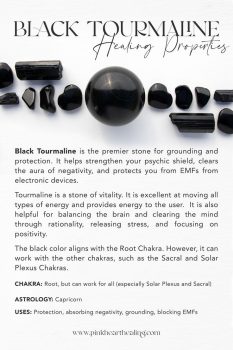
Practical Uses
Tourmaline, a versatile gemstone, boasts a wide array of practical uses beyond its aesthetic appeal. Known for its ability to generate electricity when heated or compressed, tourmaline is utilized in various industries for its piezoelectric properties. This unique characteristic makes it a valuable component in pressure sensors, sonar equipment, and even certain types of medical devices.
In addition to its role in technology, tourmaline is also valued for its alleged metaphysical properties. Believed by some to promote emotional balance and physical healing, tourmaline is often incorporated into jewelry and accessories for its supposed ability to protect against negative energy and enhance well-being. Many individuals seek out tourmaline not only for its beauty but also for the potential positive impact it may have on their overall health and mindset.
Furthermore, tourmaline is frequently used in alternative medicine practices such as crystal healing and energy work. Advocates of these methods suggest that tourmaline can help cleanse and align the body’s energy centers. Known as chakras, these centers lead to improved vitality and spiritual harmony. Whether worn as jewelry, placed in living spaces, or used in therapeutic rituals, tourmaline continues to be a popular choice for those seeking both practical benefits and holistic well-being.
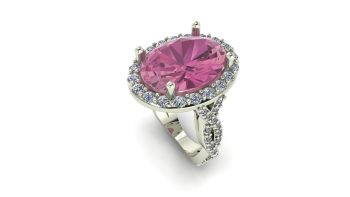
Why We Love Tourmaline Jewelry
Tourmaline has captured the hearts of many due to its stunning range of colors. From vibrant pinks to deep greens, tourmaline offers a unique and versatile option for jewelry lovers. Its beauty is further enhanced by its durability, making it a practical choice for everyday wear. It works well in interguing rings, earrings, and custom pendants.
Whether you’re drawn to tourmaline for its beauty, its believed metaphysical or physical properties, or all three, there’s no denying the allure of this gemstone. With its striking colors and purported positive effects, tourmaline jewelry continues to be a popular choice for those seeking both style and substance in their accessories.

